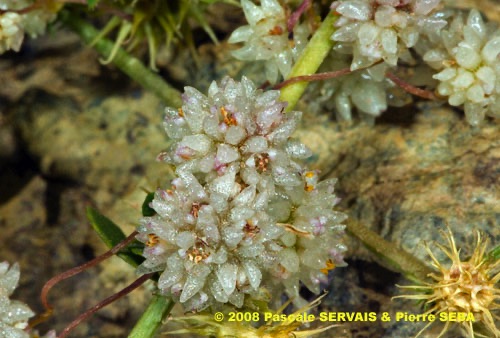
Cuscuta palaestina Boiss.
Fam. : Cuscutaceae
© Pascale SERVAIS & Pierre SEBA, 2018. Tilo Botanica: Flore de Tilos et du Dodécanèse / Flora of Tilos and of the Dodecanese
English translation by Brenda Bradbury, Howard Bradbury and Stéphane Léonard
Plante herbacée, hermaphrodite, parasite, à tiges filiformes, très ramifiées, rougeâtres, pourprées ou jaunâtres, formant un dense réseau s’enroulant autour de la plante hôte.
Feuilles réduites à de minuscules écailles, sans chlorophylle.
Fleurs à symétrie radiaire, rose pâle, blanchâtres ou lilacées, minuscules, de 2 à 3 mm de diamètre, réunies en glomérules compacts de 6 à 10 mm de diamètre. Corolle à 4 pétales (parfois 5) pointus et étalés au sommet. Calice à 4 sépales (parfois 5). 2 styles à stigmates cylindriques. 4 ou 5 étamines égales entre elles, insérées à la base de la corolle. Ovaire supère.
Fruits, capsules globuleuses.
___________________________
Plant herbaceous, hermaphrodite, parasitic. Stems thread-like, very branched, reddish, purple or yellowish, forming a dense network wrapped around the host plant.
Leaves reduced to tiny scales, without chlorophyl.
Flowers radially symmetrical, pale pink, whitish or lilaceous, tiny, from 2 to 3 mm in diameter, joined together in compact glomeruli from 6 to 10 mm in diameter. Corolla with 4 pointed petals (sometimes 5), spread out at the top. Calyx with 4 sepals (sometimes 5). 2 styles with cylindrical stigmas. 4 or 5 stamens equal between them, inserted into the base of the corolla. Ovary superior.
Fruits, globulous capsules.
Descripteurs / Identifying features
1
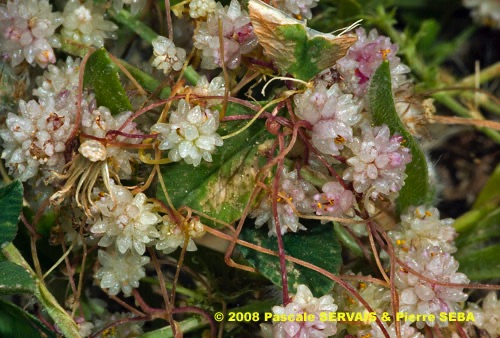
2
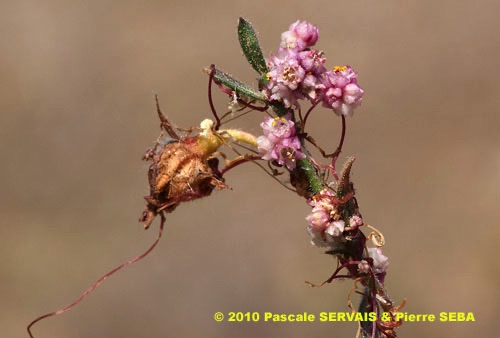
3
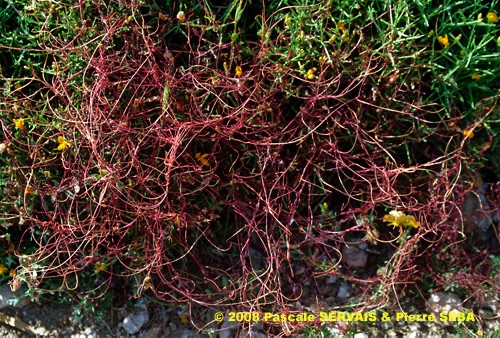
4
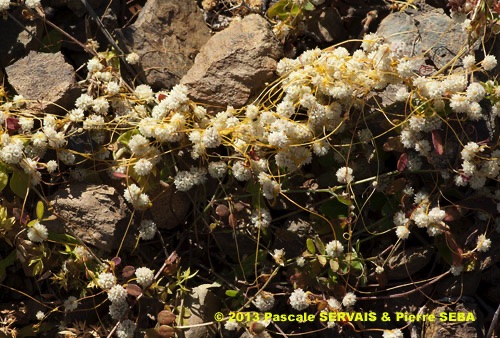
5
Étymologie / Etymology :
Cuscuta : emprunt du latin médieval cuscuta, -ae (nom) = la cuscute.
Palaestina : emprunt du latin palaestinus, -a, -um (adj.) = de Palestine,
qui provient de Palestine.
Cuscuta : borrowed from medieval Latin cuscuta, -ae (noun) = dodder.
Palaestina : borrowed from Latin palaestinus, -a, -um (adj)
= of or from Palestine.
Synonymes / Synonyms :
Cuscuta globularis Bertol.
Cuscuta palaestina subsp. palaestina
Noms vernaculaires / Common names :
Nom français / French name :
Cuscute de Palestine.
Noms grecs / Greek names :
Αμπελοκλαδιά — Κουσκούτα — Κουσκούτα η Παλαιστίνια — Λύκος —
Μαλλιά — Μαλλιά της Παναγιάς — Μετάξι — Νεραϊδογνέματα.
Nom anglais / English name :
Palestinian dodder.
Nom allemand / German name :
Palästina-Seide.
Nom italien / Italian name :
Cuscuta palestinese.
Habitat :
Forêts - Lieux pierreux - Lieux incultes.
Forests - Stony places - Waste ground.
Île / Island :
Tilos.
Hauteur / Height range :
De 10 cm à 50 cm.
From 10 cm to 50 cm.
Floraison / Flowering time :
D’avril à octobre.
From April to October.
Groupe / Classification :
Dicotylédones.
Dicotyledons.
Pérennité / Lifespan :
Annuelle.
Annual.
Description :
Photo 1 :
Localisation / Location : Tilos, Megalochorio, Plaka
Date : 19/04/2008
GPS : Lat. 36,46366° N / Long. 27,30495° E / Alt. 30 m
Type : Photographie numérique / Digital Photograph (10 mégapixels)
Photo 2 :
Localisation / Location : Tilos, Megalochorio, Plaka
Date : 19/04/2008
GPS : Lat. 36,46366° N / Long. 27,30495° E / Alt. 30 m
Type : Photographie numérique / Digital Photograph (10 mégapixels)
Photo 3 :
Localisation / Location : Tilos, Livadia, Village
Date : 06/05/2010
GPS : Lat. 36,40868° N / Long. 27,39029° E / Alt. 31 m
Type : Photographie numérique / Digital Photograph (10 mégapixels)
Photo 4 :
Localisation / Location : Tilos, Livadia, Chemin de Lethra
Date : 26/04/2006
GPS : Lat. 36,42338° N / Long. 27,38839° E / Alt. 60 m
Type : Kodak Gold 200 ASA
Photo 5 :
Localisation / Location : Tilos, Megalochorio, Plaka
Date : 28/04/2013
GPS : Lat. 36,46367° N / Long. 27,30495° E / Alt. 30 m
Type : Photographie numérique / Digital Photograph (10 mégapixels)

Google Maps
Google Maps
Google Maps
Google Maps
Google Maps